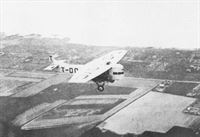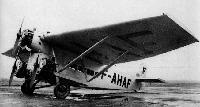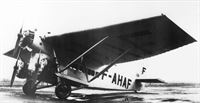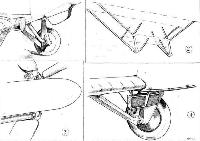
Варианты
- Farman - F.120 / F.3X / F.4X Jabiru - 1923 - Франция
- Farman - F.160 - 1924 - Франция
- Farman - F.170 Jabiru - 1925 - Франция
Farman F.121 Jabiru
Необычный самолет с огромным крылом с широкой хордой и толстым профилем, выполненным по схеме подкосного высокоплана, был выбран "Farman" для участия в официальном конкурсе "Grand Prix des Avions Transports" 1923 года. Прототип Farman F.3X Jabiru был построен вовремя, чтобы победить во всех этапах конкурса. Силовая установка F.3X состояла из четырех двигателей Hispano-Suiza 8Ac, тандемно установленных на коротких пилонах - "крылышках" в нижней части фюзеляжа. Первоначально охлаждение двигателей осуществлялось с помощью установленных на подкосах радиаторов, оказавшихся неэффективными, что привело к задержке производства, и был опробован вариант с двигателями Lorraine.
Четыре экземпляра варианта F.4X были построены в 1925 году. Они отличались от F.3X силовой установкой из трех незакапотированных радиальных двигателей Salmson AZ.9 по 300 л. с. (224 кВт), один из которых размещался сверху носовой части фюзеляжа, а боковые были выдвинуты вперед и сдвинуты как можно ближе друг к другу. Трехдвигательная компоновка отрицательно сказалась на пассажировместимости самолета. Если на F.3X два пассажира сидели в остекленной носовой части фюзеляжа, один - справа от пилота, еще семь - в пассажирской кабине, то F.4X мог перевозить только семь человек.
Эксплуатация четырех F.4X началась в первые месяцы 1925 года, они открыли линию компании "Lignes Farman" из Парижа в Цюрих. Летные характеристики самолетов оказались невысокими - на протяжении 1925 года были потеряны две машины, после чего оставшиеся машины сняли с регулярных маршрутов. F.4X с укороченной носовой частью и поднятой кабиной пилота был продемонстрирован на Парижском авиасалоне в 1924 году, но больше о его судьбе ничего неизвестно.
Серия из семи пассажирских самолетов F.3X, получивших к тому времени обозначение F.121, была построена в 1924-1926 годах. Окончательный вариант доработанной системы охлаждения был опробован на прототипе F.3X, после чего его обозначение изменили на F.121a. Один F.121 был передан "Farman" для испытаний в государственный центр S.T.Ае. и впоследствии продан за рубеж. В 1926 году четыре самолета начали полеты на линии "Farman", связывающей Париж с Брюсселем и Амстердамом, а две оставшиеся машины были проданы датской компании D.D.L. Позднее для D.D.L. в Дании по лицензии построили еще два самолета. Эти четыре машины обслуживали линии между Копенгагеном, Гамбургом и Кёльном, последняя из них была списана в 1931 году.
Единственный F.123 был прототипом бомбардировщика, сохранившим общую концепцию Jabiru. Он имел внутренний бомбоотсек, носовую и верхнюю стрелковые точки и был оснащен двумя двигателями Hispano-Suiza по 450 л. с. (336 кВт). Очень похожий на него самолет F.124, но уже с двигателями Gnome-Rhone Jupiter по 420 л.с (313 кВт), тоже не вышел из стадии отработки.
ТАКТИКО-ТЕХНИЧЕСКИЕ ХАРАКТЕРИСТИКИ
Тип: пассажирский самолет
Силовая установка: четыре V-образных 8-цилиндровых поршневых двигателя Hispano-Suiza 8Ac мощностью по 180 л. с. (134 кВт)
Летные характеристики: максимальная скорость 225 км/ч; крейсерская скорость 175 км/ч; потолок 4000 м; дальность 650 км
Масса: пустого снаряженного 3000 кг; максимальная взлетная 5000 кг
Размеры: размах крыла 19,00 м; длина 13,68 м; высота 4,48 м; площадь крыла 81,00 м2
Описание:
- Farman F.121 Jabiru
- Flight, October 1923
WINNERS OF THE FRENCH "GRAND PRIX" - Flight, December 1924
The Paris Aero Show 1924
Фотографии
-
Flight 1923-10 / Flight
THE FARMAN F.3X: This four-engined monoplane secured first place in the French "Grand Prix."
-
Aeroplane Monthly 1985-07 / J.Stroud - Wings of Peace
Регистрационный номер: F-ESAR [3] The prototype, F-3X Jabiru with strut-mounted radiators. The unpainted ply fuselage covering can be clearly seen.
-
Aeroplane Monthly 1985-07 / J.Stroud - Wings of Peace
Регистрационный номер: F-ESAR [3] F-ESAR, the F-3X prototype, with Lamblin radiators.
-
Flight 1924-09 / Flight
Регистрационный номер: F-ESAR [3] The Farman F.121 "Jabiru," four Hispano-Suiza engines, which won this year's Grand Prix for commercial aeroplanes.
-
Aeroplane Monthly 1985-07 / J.Stroud - Wings of Peace
Регистрационный номер: F-AIAN [4] Farman Line's nine-passenger F-3X Jabiru F-AIAN with triangular radiators and modified undercarriage.
-
Мировая Авиация 126
Регистрационный номер: F-AIAN [4] Необычно выглядевший Farman F.3X оказался не слишком удачным пассажирским самолетом. Короткое крыло малого удлинения было характерно для разработок "Farman", а использование радиаторов Ламблена являлось в то время общепринятой французской практикой.
-
Aeroplane Monthly 1985-07 / J.Stroud - Wings of Peace
Регистрационный номер: F-AIAN [4] This view of the Farman F-3X F-AIAN emphasises the aircraft's unusual layout
-
Aeroplane Monthly 1985-07 / J.Stroud - Wings of Peace
Регистрационный номер: F-AIAU Farman Line's F-3X Jabiru F-AIAU at Brussels.
-
Aeroplane Monthly 1985-07 / J.Stroud - Wings of Peace
Регистрационный номер: T-DOXB [2] DDL's F-3X Jabiru T-DOXB c/n 6 with modified undercarriage and cabin windows and triangular radiators.
-
Aeroplane Monthly 1985-07 / J.Stroud - Wings of Peace
Регистрационный номер: T-DOXB [2] The mysterious F-3X Jabiru T-DOXB at Kastrup, with Lamblin radiators, unmodified undercarriage and early form of cabin windows.
-
Aeroplane Monthly 1985-07 / J.Stroud - Wings of Peace
Регистрационный номер: T-DOXC A rare picture of DDL's F-3X Jabiru T-DOXC in flight. DDL's Jabirus carried two crew members.
-
Flight 1928-08 / Flight
THE AMSTERDAM AIR TERMINUS: The lower photograph shows the hangars, offices, etc. at the Schiphol aerodrome. The international character of this Dutch airport may be gathered from the machines in front of the buildings, which include a Farman "Jabiru," a three-engined Junkers monoplane, a Fokker monoplane, and a Dornier monoplane. The upper photograph shows the aerodrome restaurant where excellent meals are served, and from which a good view of the aerodrome, machines, etc. is obtained.
Другие самолёты на фотографии: Dornier Do.B Merkur - Германия - 1925Fokker F.VII / C-2 / F.XIV - Нидерланды - 1924Junkers G 23 / G 24 - Германия - 1924
-
Flight 1924-12 / Flight
FARMANS AT THE PARIS AERO SHOW: The large twin-engined (400 h.p. Lorraine) "Jabiru" commercial "semi-sesquiplan." Note the pilot's elevated position. It was this type of machine which won the last two Grand Prix competitions for commercial aeroplanes.
-
Мировая Авиация 126
Регистрационный номер: F-AHAF [2] Справедливо претендующий на достойное место в списке самых уродливых самолетов в мире, Farman F.4X был трехмоторным вариантом F.3X. Пилот размещался в открытой кабине позади центрального двигателя.
-
Aeroplane Monthly 1985-07 / J.Stroud - Wings of Peace
Регистрационный номер: F-AHAF [2] CIDNA’s first F-4X Jabiru, which was rebuilt as an F-3X.
-
Air Pictorial 1958-08 / Scrapbook
The French have a name for such offspring - 'les monstres'. Perhaps the less said about this 'flying barndoor" the better. Let it suffice that this is the Farman F.3X Jabiru (that's not in my French primer) trimoteur - Salmson experimental commercial transport of the summer of 1924. The wooden, four-blade propellers are described as "acoustique", but I'm not getting involved in that one either. The standard F.3X had only two engines while the Danish version, the F.4X or F.104, had four engines. These were the days when everyone liked to put the horses way up front and not a la Caravelle and D.H.121 et al. There was a place for the pilot - he rode the monster from a seat in the gallery, in the wing leading edge immediately behind the middle Salmson.
-
Aeroplane Monthly 1985-07 / J.Stroud - Wings of Peace
The cabin of a Farman Line F-3X Jabiru.
-
Aeroplane Monthly 1985-07 / J.Stroud - Wings of Peace
Регистрационный номер: F-AIAN [4] KEITH WOODCOCK'S painting depicts one of the Farman Line’s Farman F-3X Jabirus.
-
Aeroplane Monthly 1987-01
Most of my paintings have some remote chance of being possible. I take care to collect accurate reference and correct details to back up my idea Seemingly unconnected elements - girl machine / graphic style - are arranged in a compatible time slot, e g Jane Russell/B-17, Marlene Dietrich/Ju 90 etc. This one, I am afraid, is way off, and is just what the title says, my personal French favourites.
Bebe would have been about 2yr old when l'Armee de l'Air fielded this frightful formation of flying glasshouses. She had become a sweet fifteen by the time Saoutchik fashioned this chrome gateau of a car - the 1949 Delahaye 175 I cannot find any aviation connection, alas, for the Sex Kitten, perhaps, then, she is fortunate to have both feet firmly on the ground while the Force de Frappe drones overhead. Who said Concorde was noisy...?
Anticlockwise, the bombers are Farman F 221, Farman F4-X (transport), Farman F 221-10, Amiot 143, Aerienne Bordelaise AB 21, Amiot 143, Breguet 460, Potez 540.Другие самолёты на фотографии: Amiot Amiot 140 / Amiot 143BN5 - Франция - 1931Breguet Br.460 Vultur - Франция - 1935Dyle et Bacalan / SAB AB-20 / AB-21 - Франция - 1932Farman F.220 / F.221 / F.222 - Франция - 1932Potez Potez 54 - Франция - 1933
-
Flight 1924-12 / Flight
SOME FARMAN DETAILS: 2. Diagrammatic perspective sketch of the system of bracing employed in the two Farman sesquiplans. 3. Wing strut attachments and undercarriage hinge on the Farman "Jabiru." 4. One side of the "Jabiru "undercarriage. Note the radiator position and the locking rod of the engine cowling.
- Фотографии




















